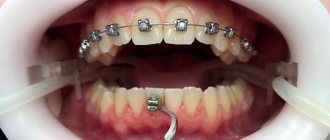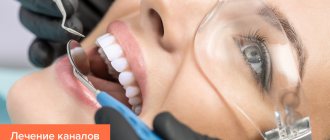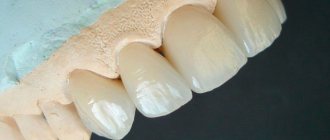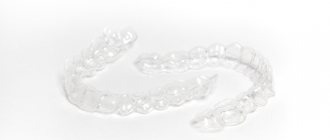Excursion into history | Ligature and self-ligating constructions | Biomechanics of tooth movement | System installation | Stages of treatment | Lingual and vestibular structures
Braces are locks fixed to the teeth with a groove and “wings”. The principle of operation of the system is the ability of the orthodontic arch to return to its original position. The straightening archwire puts pressure on the braces, causing the teeth to move. Fixed retainers and aligners stabilize the results obtained at the final stage of treatment.
The material was verified by Anna Rimkevich, senior product manager at Ormco Russia.
The basis of bite correction is the mechanism of action of weak forces and the movement of teeth in accordance with the bends and shape of the arch. The metal arch has “shape memory”: it straightens, pulls the braces along with it and moves the teeth in the desired direction. The formation and destruction of bone tissue is part of the natural process of tooth movement. The principle of operation of braces allows you to achieve the goal of orthodontic treatment - to create the best balance of occlusion, facial aesthetics and dentition.
Damon Clear with orthodontic arch
Stage No. 1. Visit to the orthodontist
This is the doctor you should make an appointment with to find out if braces treatment is right for you.
During the consultation, the specialist assesses the position of the teeth and, if according to the indications, braces are suitable for the patient, he offers options for braces with the obligatory indication of the estimated time frame and cost of treatment.
Of course, the orthodontist will talk about preparation for treatment, answer all the patient’s questions and send him home to make a decision. If the patient does not need time to think, you can go straight to the second stage.
Teeth hurt after braces tightening
We hasten to reassure you: this is natural and normal, because the pressure increases, and some discomfort, as at the very beginning, after installing braces, is inevitable. However, you should immediately tell your doctor about severe pain - constant discomfort that does not go away the next day after the tightening cannot be felt. You don’t have to endure it if the wire of the braces interferes with you and you touch it with your gums or tongue.
Dentist advice:
Before the braces tightening procedure, it is better to think through your diet in advance for a day or two in advance - exclude food that needs to be chewed vigorously and leave something simpler, soft food (yogurt, cereal, puree);- It is better to eat and brush your teeth before the procedure - afterward, due to the sensitivity of the teeth, it will be more difficult;
- Talk to your doctor about what type of pain medication you can take if the pain bothers you. Important: do not take painkillers or anti-inflammatory drugs on an empty stomach;
- After meals, you can (and even should) use an antibacterial mouth rinse.
Stage No. 2. Diagnostics
Diagnostic measures usually take from half an hour to an hour and consist of the following:
- orthopantomogram - a panoramic image of both jaws;
- teleroentgenogram (TRG) - a photograph of the skull in frontal and lateral projection;
- photographing teeth, as well as the face in profile and full face;
- taking impressions of both jaws.
Based on the diagnostic results, the doctor draws up an individual treatment plan for braces and virtual simulation of the result. All information is entered into the outpatient card, and the patient is referred to doctors of related specialties.
What is the bite like?
Occlusion - the position of the upper and lower dentition in the position of central occlusion. All types of bite can be divided into physiological and pathological.
Physiological:
- Orthognathic is the “ideal” variant of the bite, which is characterized by tight contacts between the teeth and dentition, as well as overlapping of the lower dentition by 1/3 of the crown;
- Biprognathic - a bite in which the crowns of the teeth are directed towards the vestibule of the mouth;
- Progenic – a bite characterized by a slight protrusion of the lower jaw forward;
- Direct - a type of bite in which, in the position of central occlusion, the upper and lower dentition touch the cutting edges.
These types of occlusion are allowed as variants of the norm of mutual arrangement of the dentition, since they are not capable of leading to functional disorders of the dentoalveolar system.
Pathological:
- Mesial – a bite characterized by protrusion of the lower jaw forward;
- Distal - a bite in which the upper jaw is more massive than the lower jaw;
- Deep - a bite in which the upper teeth strongly overlap the lower ones;
- Crossbite - a bite in which individual teeth of the lower jaw overlap the upper teeth in a separate area;
- An open bite is a bite in which gaps are formed between the closed teeth.
Pathological types of occlusion cause functional disorders in the dental system, and also, in some cases, disrupt the aesthetics of a smile.
Only an experienced orthodontist can most accurately determine the type of bite and draw up a treatment plan. Request an appointment in Moscow with Irina Aleksandrovna Butorina. The specialist has many years of experience, as well as more than a thousand satisfied patients.
Stage No. 3. Preparing for treatment with braces
Patients who visit the dentist at least once a year and regularly undergo professional teeth cleaning usually do not need a preparatory stage. Teeth and gums need to be healthy, so other patients may need:
- treatment of caries by a dentist;
- treatment of gums by a periodontist;
- A visit to a dental surgeon is required in difficult cases, for example, to correct a tongue frenulum.
Professional teeth cleaning is always part of the preparation for treatment with braces.
Why do you need braces tightening?
Braces lift
- a mandatory stage in the treatment of malocclusion, and a regular procedure that must be carried out if you want to achieve results. It's all about the mechanism of braces: the bracket, which puts pressure on the teeth, forcing the dentition to take the correct shape, reduces the pressure over time, and it must be tightened so that the effectiveness of the treatment does not decrease.
How often are braces tightened?
- is an individual question.
As often as necessary to straighten teeth. On average, a patient comes for a facelift procedure once every 2-3 months
, as prescribed by an orthodontist. The exact timing depends on many factors: the type of braces installed, the condition of the patient’s teeth, and the overall speed of treatment.
We remember that the treatment with braces itself lasts about 3-4 years - which means you will have to visit the dentist quite often, this is necessary not only to control the treatment, but also for periodic examination of the teeth, because caries forms under braces in the same way as on regular ones teeth
Stage No. 4. Installation of bracket systems
Depending on the type of orthodontic structure, fixing the braces takes from 1 to 2 hours and does not cause pain to the patient. The only condition is to come to the doctor, preferably after eating heavily, otherwise the process will cause excessive salivation.
As the work progresses, the orthodontist explains all the manipulations and talks in detail about the rules of hygiene when wearing braces.
Does it make sense to get braces as an adult?
Correcting a pathological bite or incorrect position of teeth is, of course, not a matter of life and death. Rather, it is a matter of regaining self-confidence. The “curvature” of teeth has little effect on communication; after all, we perceive a person holistically, and not solely the state of his bite. But, you see, an open wide smile of any person will make him more attractive in our eyes. And only people who are not embarrassed to show off their teeth smile like that. Plus, when we talk about bite, it's not just about beauty, it's also about functionality. Nature intended that when chewing, the load on the teeth should be distributed evenly - this is only possible with straight teeth and a healthy bite. If this is not the case, then over time a person develops problems with the dental system: pain appears, clicks when opening and closing the mouth, etc. Therefore, orthodontic treatment for adult patients is not only possible, but also necessary.
Stage No. 7. Installation of retainers
Retainers are a group of orthodontic devices that are placed after braces are removed to secure the result.
The shape of the retainer is selected individually, as well as the material - polymer or metal and the method of attachment - removable or non-removable. Retainers are installed after professional teeth cleaning. The process takes about 15 minutes.
The duration of the retention period is different for everyone, and can range from 8 months to 5-6 years. You can talk about reducing the length of time you wear a retainer after control visits to the orthodontist every six months.
The author of the article is an orthodontist, Olga Vladimirovna Chugunova.
How much does orthodontic treatment with braces cost?
The main part of the cost of orthodontic treatment consists of the cost of the orthodontic apparatus on which the treatment is performed and the cost of the orthodontist’s work.
You also need to include indirect costs here:
- Cost of initial orthodontic consultation.
- Cost of diagnostics.
- The cost of preparation for orthodontic treatment (sanitation of the oral cavity, professional hygiene, tooth extraction, if your treatment plan includes it.
- The cost of the necessary additional orthodontic equipment (springs, miniscrews, orthodontic rods - elastics, etc.)
- The cost of regular professional hygiene, which you will have to undergo every 4-6 months throughout the entire orthodontic treatment.
- Cost of special orthodontic daily hygiene products.
The cost of orthodontic treatment indicated on the website and in other public sources is always approximate, indicative for the patient. You can accurately calculate it specifically for your case after diagnosis and drawing up your treatment plan.
There are 2 main payment schemes for orthodontic treatment:
- Payment for each visit.
In this case, the patient pays for his orthodontic apparatus and for each separately provided service, according to the price list. - Payment in installments in equal payments.
With this payment scheme, after the treatment plan is approved, the patient makes an advance payment, which is usually equal to the cost of the orthodontic appliance with installation, and begins treatment.
The remaining amount is divided equally by the number of predicted months of treatment, and the patient pays a monthly payment. If the treatment is still ongoing, but its cost has already been paid, the patient continues treatment until the desired result is obtained without additional payments.
Patients of our clinic "GALA DENT" on Prosvet pay for orthodontic treatment according to the second payment scheme - equal monthly payments
, because we consider this form of payment more convenient and fair.
Read more about prices for dental services and payments in the section Payment system and prices.
It is important to change the arc on time
At each stage of treatment you need to get a certain result. Once it is reached and the teeth have assumed their new position, the archwire no longer works. And if you often postpone doctor's appointments, each week of delay prolongs the entire treatment.
Wearing one archwire for too long does not harm your teeth, but it does not make sense.
Treatment by an orthodontist requires self-discipline. Be prepared to adjust your schedule around your doctor's appointments. And remember that all this is done for the sake of health and a beautiful smile. And this is the best incentive!
Resilines fastening system
Fixing Resilines braces is another modern method practiced in dentistry. This is the most popular adhesive for attaching braces. Its adhesive properties are very soft and sticky, ideal for bonding any type of overbite correction. Using the composition it is possible to fix metal, sapphire and ceramic products. The adhesive quickly hardens under the influence of ultraviolet lamps. But until the braces are glued and the locks are installed, it remains soft. The metal arch can be installed immediately after attaching the locks.
Regardless of the chosen method, the orthodontist, first of all, needs to focus not on the method of fixation and type of brace system, but on the doctor’s expertise. With the right approach, any of the methods will be effective.
Braces care
You should pay close attention to your oral hygiene while wearing braces to avoid the risk of tooth decay or other complications. To care for your teeth and braces, use special devices: brushes, brushes, and irrigators to effectively remove pieces of food between the structural elements. Floss (special thread) is good for removing food debris between teeth. When using braces, you should also exclude from your diet some foods that have increased coloring properties. This way you will protect the elements from more frequent replacement. For example, ceramic braces have an increased tendency to pigmentation.
Direct technology for fixing braces
This method of attaching a corrective structure involves attaching it specifically to each tooth. The doctor installs a dilator into the patient’s oral cavity that holds the cheeks, lips, and tongue. Thus, it isolates the dental units from the soft tissues. Each tooth is cleaned with dental paste and a brush. Then, one by one, the doctor applies a special composition containing phosphoric acid. The product is harmless, does not damage the enamel, and creates microscopic roughness, which is necessary for reliable fixation of braces. Next, the orthodontist applies an adhesive bond system to the teeth, and a composite material to the brackets. Then he presses the bracket onto the tooth and the assistant uses a lamp to illuminate the composite.
Among the advantages of the method, it is worth noting the possibility of correcting structures. The downside is that such fastening is labor-intensive, since the procedure lasts approximately an hour and a half. It is uncomfortable for the patient to keep his mouth open for such a long time. The doctor will have to perform a large amount of work in one visit.










